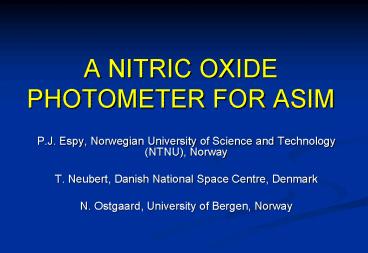A NITRIC OXIDE PHOTOMETER FOR ASIM - PowerPoint PPT Presentation
1 / 13
Title:
A NITRIC OXIDE PHOTOMETER FOR ASIM
Description:
... ASIM. P.J. Espy, Norwegian University of Science and Technology (NTNU), Norway. T. Neubert, Danish National Space Centre, ... ASIM photometer channel ... – PowerPoint PPT presentation
Number of Views:136
Avg rating:3.0/5.0
Title: A NITRIC OXIDE PHOTOMETER FOR ASIM
1
A NITRIC OXIDE PHOTOMETER FOR ASIM
- P.J. Espy, Norwegian University of Science and
Technology (NTNU), Norway - T. Neubert, Danish National Space Centre, Denmark
- N. Ostgaard, University of Bergen, Norway
2
OUTLINE
- Importance of TLE produced NOx
- Production mechanisms
- Observations
3
Importance of TLE Produced NOx
- Produced in-situ in stratosphere and mesosphere
- Primary reactions NO O3 ? NO2 O2 NO2
O ? NO O2 - Represents a catalytic loss of ozone (Net O3
O ? 2O2) - A possible mechanism influencing upper
stratospheric O3 recovery - Eventually forms N2O5 which converts to HNO3
- This reacts with stratospheric aerosols
- Participates in ozone chemistry
- Descends and precipitates out contributing to
rain acidification - Reacts with other IPCC climate change factors
(e.g. sulphate aerosols)
4
DIFFICULTIES
- It is unknown whether TLE produce NO
- If NO is created, then how can it be detected
- Some proposed production mechanisms produce NO
- resulting radiation may be observed
- Other proposed mechanisms produce ground state NO
- can be observed to fluoresce in sunlight
- Can it be observed within the limitations of the
ISS
5
NO Shock-Wave Production
- Zeldovitch-
- Shock wave dissociates N2 O2 _at_ T 30,000K
- N and O recombine to form NO
- Shock wave expands and rapidly cools to T2000K
- NO freezes out with significant NO that
radiates - Primary mechanism for tropospheric
lightning but unknown if shocks are produced by
TLE
6
High-Altitude Rocket Shocks ? NO
Rocket shock wave creates excited NO that
radiates. Emission falls off rapidly with
altitude
Ts5000K
Ts12000K
7
MODELLED TLE PRODUCTION OF NO
Production of N2(A) state in TLE
streamers Chemical production of NO Some NO
production and detectable radiation
8
Auroral Production of NOx
Electron impact of every species leads to
NOWhich subsequently recombines to form NO
But the NO is produced in the ground state Only
observed in resonance fluorescence or absorption
9
Observed Nitric Oxide Spectra
Auroral enhancement of NO fluorescing in the
dayglow A proxy for TLE produced NO
10
UV ALBEDO/SCREENING
UV absorption screens lower atmosphere while
allowing mesospheric TLE produced NO to be
observed
11
ASIM VIEW FROM SPACE
Wide field-of-view photometer 220-240 nm on ISS,
observing -15 to 5 about the limb
12
ASIM OBSERVATION OF TLE NO
Observe NO produced by TLEin the
mesosphere Either direct NO-? radiance
(dark). Or Solar fluorescence of enhanced NO
13
CONCLUSIONS
- Important but challenging measurement to make
- UV observations of NO- ? band radiance, 220-240
nm from enhanced NO - Wavelength range avoids contaminating emissions
and utilizes atmospheric absorption to screen
lower atmosphere - Either direct radiation or solar resonance
fluorescence of high-altitude NO

